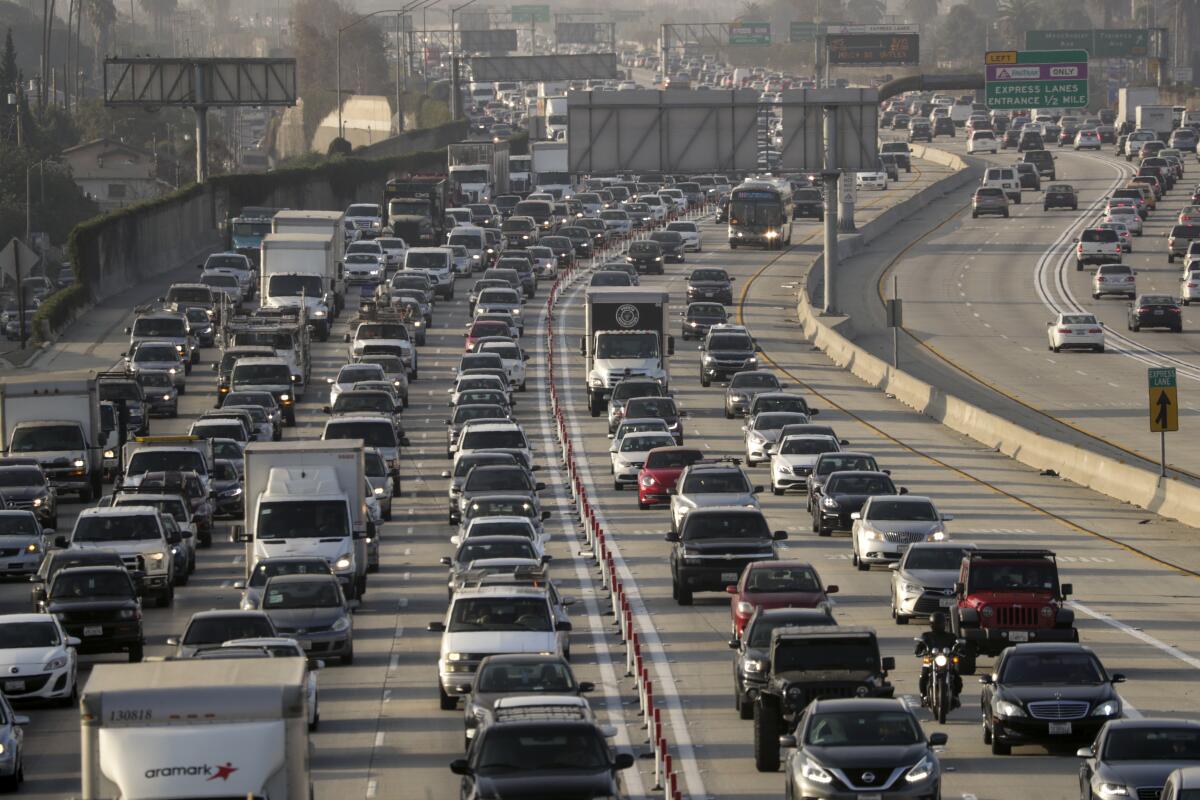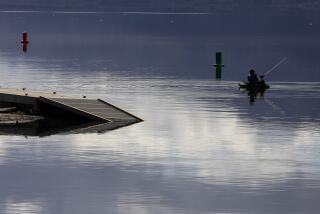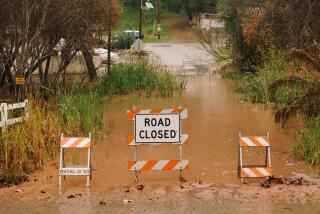Hitting the road for Thanksgiving from L.A.? This is the worst time to leave

You’re traveling for Thanksgiving by car? Then listen up: The absolute worst time to leave Southern California is 5 to 7 p.m. Nov. 27, the day before Thanksgiving, because of what is expected to be a record freeway crunch, AAA predicted.
About 3.7 million Southern Californians are expected to take a car trip of more than 50 miles during the long weekend, AAA said. They’ll be among the 55.3 million nationally who are traveling for the holiday, about 49.3 million by car. A strong economy is being credited for a 2.9% overall surge in Thanksgiving holiday travel.
Nov. 27 is expected to be the worst travel period nationally, and car trips are expected to take as much at four times longer than normal in major metropolitan areas, including Los Angeles and much of Southern California.
Factor in the forecasts for heavy rain in Los Angeles County by sunrise on Wednesday. The cold north-to-south storm is expected to drop up to three inches in the foothills and lower elevations of the mountains, with snow levels to 2,500 feet, potentially snarling the Grapevine. Pockets of heavy rain are expected into Thursday.
So leave now if you can. But you probably can’t. So ....
When not to go
When the time comes, here are some peak periods to avoid at choke points around Southern California on D-Day (departure day), Nov. 27:
- Interstate 10 eastbound from Santa Monica to the Interstate 5 interchange: 6 p.m. (with a delay five times the norm).
- Interstate 405 southbound from Roscoe Boulevard to the 110 Freeway: 5:30 p.m.
- Interstate 405 northbound from the 110 to Roscoe Boulevard: 5:45 p.m.
- Interstate 10 eastbound from State Street to West Covina: 5:15 p.m.
- U.S. 101 Freeway westbound from California 170 to California 23: 6:30 p.m.
Blame population increases nationwide for some of the growing freeway crunch, said Trevor Reed, an analyst for INRIX, a transportation data company.
Now that curbside pickups have been banned, arriving passengers have new choices to make, and understanding LAX-it will be crucial.
“Although travel times will peak on Wednesday afternoon nationally, travelers should expect much heavier than normal congestion throughout the week,” Reed said.
An unseasonably warm November is likely to increase congestion around theme parks in Anaheim and other parts of Southern California.
For most Americans, gasoline prices will be similar to last year’s. As of Nov. 18, the California retail state average was $3.95 a gallon for regular. The Los Angeles-Long Beach average is at $3.99. Among popular destinations for L.A. travelers, San Diego shows a $3.95 a gallon price and Las Vegas, $3.29.
California prices are higher than the national average ($2.57) partly because of the state’s blend of fuel to accommodate its strict environmental laws, which few refineries outside the state produce.
To the rescue
Here’s another breathtaking stat: AAA expects to rescue 368,000 California motorists on the roadside. Of those, 137,909 are expected to need a tow, 55,456 are expected to need tire assistance, and 103,871 will need battery help.
Mechanics urge motorists to take these pre-trip precautions:
- Check tires for wear and make sure all tires, including the spare, are properly inflated.
- Check all fluids, especially oil, transmission and brake levels.
- Check windshield blades, which are often dried out and brittle by this time of year.
- Inspect coolant level and condition.
- Check engine belts for cracks or tears, as well as all hoses for cracks and blisters. Belts and hoses that are more than 10 years old may need replacement just because of age.
- Test and replace old or weak batteries. The Auto Club has a mobile battery service in select areas to test your battery and replace it with a new one if necessary.
A basic emergency kit should include blankets or a sleeping bag, water, a first-aid kit, a flashlight, flares and nonperishable food. Although roads are mostly free of snow now, conditions will change rapidly once late November hits. Snow chains should always be carried anywhere near mountains in winter months.
Put this number in your phone: (800) 427-7623. That’s the CalTrans road conditions number.
Bottom line: Be safe, stay patient, be prepared.
For the Thanksgiving holiday, Amtrak’s Pacific Surfliner requires reservations. You could take a bus, with help from a new site, or even rent a Tesla.
Defense! Defense!
Finally, as you travel, drive defensively, especially when you consider that California motorists are fifth-worst in the nation in their understanding of road signs. Almost 13% of California participants failed a simple sign test, according to a study by a New York car dealership. Drivers older than 51 had the highest average grades, followed by teens, no doubt still benefiting from recent testing.
Another sobering note: Almost 8% of drivers nationwide couldn’t identify a simple “U-Turn Only” sign.
Pack that tidbit away in your brain. If nothing else, it’s fodder for the Thanksgiving table when Uncle Arnie insists on talking about tariffs or Aunt Edna starts describing her latest rash.
At that point, anything goes.
More to Read
Sign up for The Wild
We’ll help you find the best places to hike, bike and run, as well as the perfect silent spots for meditation and yoga.
You may occasionally receive promotional content from the Los Angeles Times.







